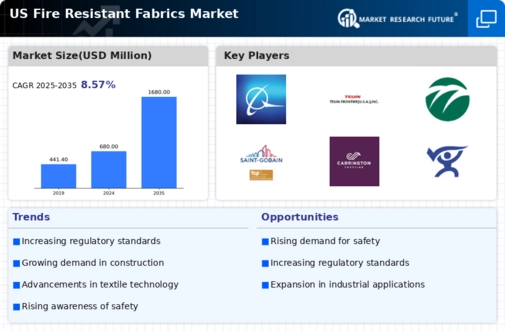The US Fire Resistant Fabrics Market is characterized by a dynamic competitive landscape where numerous players are striving to capture market share and innovate solutions that cater to safety and regulatory standards. This market has gained significance due to increased awareness regarding fire hazards in various sectors such as construction, manufacturing, and transportation.
Key players are investing in research and development to enhance the performance of fire-resistant textiles, contributing to the overall advancement of this sector. The competition is fueled by the demand for advanced materials that not only provide safety but also offer versatility and comfort for end users.
Companies are forming strategic partnerships and collaborations to enhance their product offerings and to leverage technological advancements, ensuring they remain competitive in this rapidly evolving market. Milliken and Company stands as a prominent player in the US Fire Resistant Fabrics Market, recognized for its innovative solutions and high-quality products.
The company focuses on developing advanced textiles imbued with fire-resistant properties tailored for various applications, particularly in industrial and protective clothing sectors. Milliken's strengths lie in its robust research and development capabilities, which enable it to introduce cutting-edge technologies that enhance fabric performance.
The firm's commitment to sustainability and environmentally responsible practices also resonates well with modern consumers, reinforcing its brand reputation. Furthermore, Milliken's extensive distribution network across the United States allows it to effectively serve a diverse clientele, positioning it favorably within the competitive framework of the fire-resistant fabrics market.
Boeing plays a significant role within the US Fire Resistant Fabrics Market, particularly through its focus on providing fire-safe materials for aerospace applications. The company's key products and services include advanced fabric solutions designed to meet stringent safety regulations in aircraft manufacturing and maintenance.
Boeing's presence in this market is bolstered by partnerships with various suppliers and ongoing commitments to innovation, ensuring its offerings align with the latest industry standards. The company's strengths lie in its extensive experience and deep understanding of specialized applications requiring fire-resistant features.
Additionally, Boeing has been involved in mergers and acquisitions that enhance its technological capabilities, further enriching its portfolio in the fire-resistant sector. As a result, Boeing is well-positioned to meet the growing demand for fire-resistant fabrics, ensuring safety within the highly regulated aerospace industry in the US.

















Leave a Comment